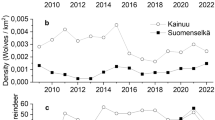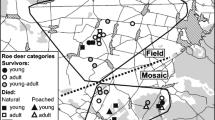Abstract
Survival and cause-specific mortality rates of female sika deer (Cervus nippon) were studied using radio telemetry in eastern Hokkaido, Japan. We captured and radio-collared 18 female deer, and monitored their survival from April 1993 to May 1996. Estimated annual survival rate for adult females was 0.779 (95% confidence interval was 0.609–0.997). The harvest mortality rate of adult females was higher than the natural mortality rate. Experimental female hunting during 1994–1996 contributed to an increase in the mortality rate for females and was useful in the control of the sika deer population.

Similar content being viewed by others
References
Ballard WB, Whitman JS, Reed DJ (1991) Population dynamics of moose in south-central Alaska. Wildl Monogr 114:1–49
Begon M, Harper JL, Townsend CR (1996) Ecology: individuals, populations and communities, 3rd edn. Blackwell Science, Oxford
Caughley G (1966) Mortality patterns in mammals. Ecology 47:906–918
Caughley G (1977) Analysis of vertebrate populations. Wiley, N.Y.
Downing RL (1980) Vital statics of animal populations. In: Schemnitz SD (ed) Wildlife management technique manual, 4th edn. The Wildlife Society, Washington, DC, pp 247–267
Eberhardt LL (1985) Assessing the dynamics of wild populations. J Wildl Manag 49:997–1012
Environmental Agency (1987) The third national survey on natural environment (vegetation). Environmental Agency. Tokyo
Fuller TK (1990) Dynamics of a declining white tailed deer population in north central Minnesota. Wildl Monogr 110:1–37
Gaillard JM, Festa-Bianchet M, Yoccoz NG (1998) Population dynamics of large herbivores: variable recruitment with constant adult survival. Trends Ecol Evol 13:58–63
Heisey DM, Fuller TK (1985) Evaluation of survival and cause specific mortality rates using telemetry data. J Wildl Manag 49:668–674
Hokkaido Institute of Environmental Sciences (1997) Results of a survey related to sika deer and brown bear in Hokkaido III (in Japanese). Hokkaido Institute of Environmental Sciences, Sapporo, Japan
Hokkaido Institute of Environmental Sciences (2000) Results of a survey related to sika deer and brown bear in Hokkaido IV (in Japanese). Hokkaido Institute of Environmental Sciences, Sapporo, Japan
Hokkaido Institute of Environmental Sciences (2004) Statistics of harvest for sika deer in Hokkaido, 1986–2001 (in Japanese). Hokkaido Institute of Environmental Sciences, Sapporo, Japan
Inukai T (1952) The sika deer in Hokkaido and its rise and decline (in Japanese). Hoppo Bunka Kenkyu (Rep North Culture Res) 7:1–45
Igarashi T (1986) Forest vegetation of the Akan National Park, Hokkaido, Japan (in Japanese with English summary). Res Bull College Exp For, Faculty Agric, Hokkaido Univ 43:335–494
Japan Meteorological Agency (1996) Monthly meteorological report in Hokkaido, vol 40 (in Japanese). Sapporo District Meteorological Observatory
Kaji K, Miyaki M, Saitoh T, Ono S, Kaneko M (2000) Spatial distribution of an expanding sika deer population on Hokkaido Island, Japan. Wildl Soc Bull 28:699–707
McCorquodale SM (1999) Movements, survival, and mortality of black-tailed deer in the Klickitat basin of Washington. J Wildl Manag 63:861–871
McCullough DR (1979) George reserve deer herd. The University of Michigan Press, Mich.
Miyaki M, Nishikawa Y (2001) Availability of summer forage for sika deer in the broad-leaved forests in eastern Hokkaido. In: Study on conservation and management of sika deer in Hokkaido, 1996–2000 (in Japanese). Hokkaido Institute of Environmental Sciences, Sapporo, Japan, pp 51–70
Nelson ME, Mech LD (1981) Deer social organization and wolf predation in northeastern Minnesota. Wildl Monogr 77:1–53
Nelson ME, Mech LD (1986) Mortality of white-tailed deer in northeastern Minnesota. J Wildl Manag 50:691–698
Ohtaishi N (1976) Life table for Japanese deer at Nara Park and its characteristic (in Japanese with English summary). Annual Report of Nara Deer Research Association 1976, pp 83–95
Roseberry JL, Woolf A (1991) A comparative evaluation of techniques for analyzing white-tailed deer harvest data. Wildl Monogr 117:1–59
Sakuragi M, Igota H, Uno H, Kaji K, Kaneko M, Akamatsu R, Maekawa K (2003) Seasonal habitat selection of an expanding sika deer (Cervus nippon) population in eastern Hokkaido, Japan. Wildl Biol 9:141–153
Suzuki M (1999) A review of capture myopathy (in Japanese). Honyurui Kagaku (Mammal Sci) 39:1–8
Suzuki M, Kaji K, Yamanaka M, Ohtaisi N (1996) Gestational age determination, variation of conception date, and external fetal development of sika deer (Cervus nippon yesoensis Heude, 1884) in eastern Hokkaido. J Vet Med Sci 58:505–509
Takatsuki S, Miura S, Suzuki K, Ito-Sakamoto K (1991) Age structure in mass mortality in the Sika deer (Cervus nippon) population on Kinkazan Island, northern Japan. J Mammalog Soc Jpn 15:91–98
Trent TT, Rongstad OJ (1974) Home range and survival of cottontail rabbits in southwestern Wisconsin. J Wildl Manag 38:459–472
Uno H, Kaji K (2000) Seasonal movements of female sika deer in eastern Hokkaido, Japan. Mammal Study 25:49–57
Uno H, Kaji K, Suzuki M, Yamanaka M, Masuda Y (1996) Evaluation of the Alpine Capture Systems cloth trap for sika deer (in Japanese with English summary). Honyurui Kagaku (Mammal Sci) 36:25–32
Uno H, Yokoyama M, Takahashi M (1998) Winter mortality pattern of Sika deer (Cervus nippon yesoensis) in Akan National Park, Hokkaido (in Japanese with English summary). Honyurui Kagaku (Mammal Sci) 38:233–246
Van Deelen TR, Campa H, Haufler JB, Thompson PD (1997) Mortality patterns of white tailed deer in Michigan’s upper peninsula. J Wildl Manag 61:903–910
White GC, Garrott RA (1990) Analysis of wildlife radio-tracking data. Academic Press, San Diego
White GC, Gallott RA, Bartmann RM, Carpenter LH, Alldredge AW (1987) Survival of mule deer in northwest Colorado. J Wildl Manag 51:852–859
Whitlaw HA, Ballard WB, Sabine DL, Young SJ, Jenkins RA, Forbes GJ (1998) Survival and cause-specific mortality rates of adult white-tailed deer in New Brunswick. J Wildl Manag 62:1335–1341
Acknowledgments
We are very grateful to H. Mizuno, M. Yokoyama, students of Hokkaido University (Brown Bear Research Group) and Tokyo University of Agriculture for assisting with collection of data; and the staff of Bihoro Museum, Abashiri and Kushiro Sub-prefecture, Hokkaido Government, and Maeda Ippoen Foundation for supporting our work. We are also great thankful to T. Saito and anonymous referees for critically reading and help to improve our manuscript. This study was partly supported by a grant from Bihoro town and Ministry of Education, Culture, Sports, Science and Technology.
Author information
Authors and Affiliations
Corresponding author
About this article
Cite this article
Uno, H., Kaji, K. Survival and cause-specific mortality rates of female sika deer in eastern Hokkaido, Japan. Ecol Res 21, 215–220 (2006). https://doi.org/10.1007/s11284-005-0111-4
Received:
Accepted:
Published:
Issue Date:
DOI: https://doi.org/10.1007/s11284-005-0111-4




